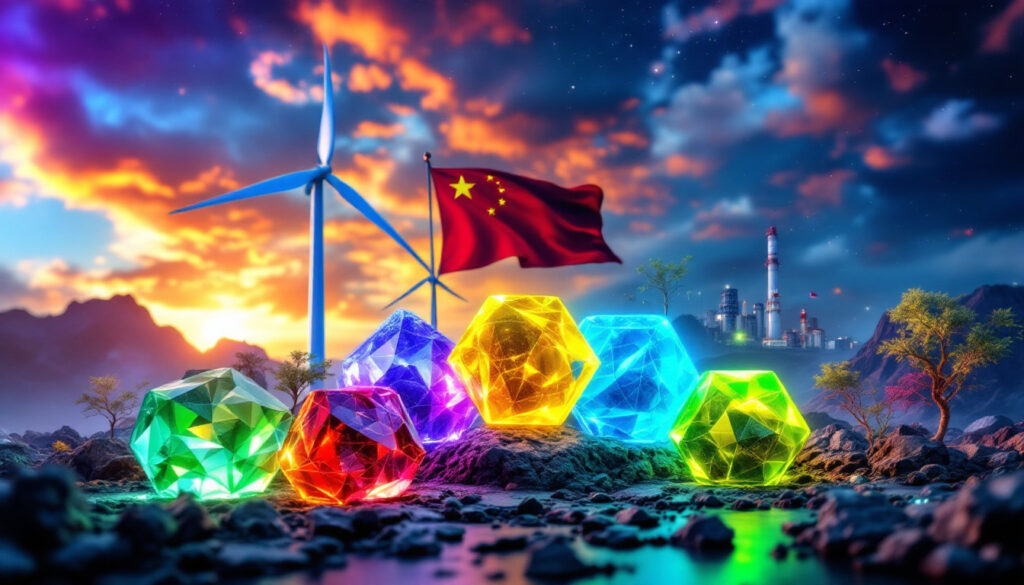What Are Rare Earth Elements and Why Are They Strategic Resources?
Rare earth elements (REEs) comprise a group of 17 metallic elements found in the periodic table, including the 15 lanthanides plus scandium and yttrium. Despite their name, these elements aren't particularly rare in Earth's crust—they're actually relatively abundant. What makes them challenging is their dispersed distribution and the complex, expensive processes required to extract, separate, and refine them into usable forms.
The Misnamed Minerals: Understanding REE Abundance
Rare earth elements earned their misleading name not because of scarcity but due to:
- Their dispersed distribution (rarely found in concentrated deposits)
- Complex chemical properties making separation difficult
- The requirement for multiple processing steps to isolate individual elements
- The environmental challenges associated with extraction and processing
As Rowena Smith, CEO of Australian Strategic Materials, explains: "They're not rare but require 18–20 years to develop a mine. They're generally found in combination with each other, making extraction, separation, and refinement extremely complex and requiring multiple processing steps."
Critical Applications Driving Strategic Importance
REEs have become indispensable for modern technologies and the clean energy transition:
| Application Area | REE Use | Strategic Significance |
|---|---|---|
| Clean Energy | Wind turbine magnets, EV motors | Essential for decarbonization |
| Defense | Precision-guided weapons, radar systems | National security implications |
| Electronics | Smartphones, LED screens, hard drives | Consumer technology foundation |
| Medical | MRI machines, surgical tools | Healthcare advancement |
| Aerospace | Jet engines, spacecraft components | Advanced transportation |
Key Insight: The strategic value of rare earths lies not in their rarity but in their irreplaceability for technologies critical to economic growth, national security, and the energy transition. As Ahmad Ghahreman, CEO of Cyclic Materials, notes: "Rare earths are 'vitamins' for tech—small amounts are irreplaceable for performance."
Only about 1% of rare earth elements are currently recycled, compared to recycling rates of 30-70% for base metals like aluminum, copper, and lead. This stark disparity represents a significant missed opportunity in the rare earth supply chain.
How Did China Establish Dominance in the Rare Earth Supply Chain?
China's control over the rare earth market didn't happen by accident. It resulted from a decades-long strategic vision that recognized the future importance of these elements long before Western nations did.
The Historical Shift: From Western to Chinese Dominance
The global rare earth supply chain has undergone dramatic shifts:
- 1950s-1960s: South Africa dominated production
- 1960s-1980s: The United States was the world's leading producer (Mountain Pass mine in California)
- 1990s-Present: China established and maintained market dominance
China's Strategic Approach to Rare Earth Development
China's rise to dominance followed a deliberate industrial policy:
- Early Recognition: In the early 1990s, Deng Xiaoping famously stated, "The Middle East has oil, China has rare earths"
- Government Support: Subsidized mining operations and processing facilities
- Technology Development: Heavy investment in extraction and separation technologies
- Vertical Integration: Building a complete supply chain from mining to magnet production
- Aggressive Pricing: Using low prices to drive Western competitors out of the market
- Export Restrictions: Implementing quotas to maintain control
As Rowena Smith explains: "China deliberately priced intermediates below Western production costs to systematically eliminate competition. Their vertical integration allows them to control every stage from mining to finished magnets."
This coordinated approach resulted in China controlling approximately 60% of global rare earth reserves by 2024 and over 90% of processing and magnet manufacturing by 2024.
The Market Concentration Problem
The current market concentration presents significant challenges:
- 60% of rare earth mining occurs in China
- 90% of processing capacity is located in China
- 92% of rare earth magnets are manufactured in China
This concentration creates vulnerability in global supply chains, as demonstrated during COVID-19 disruptions when even luxury car manufacturers in Europe couldn't source the magnets needed for power windows and seats.
What Are the Geopolitical Implications of Rare Earth Trade Restrictions?
The strategic importance of rare earths has made them a focal point in international trade tensions, with significant implications for global commerce and security.
Recent Trade Tensions and Export Restrictions
In April 2025, China implemented new China's export restrictions on seven heavy rare earth metals and magnets:
- Export licenses now required for samarium, gadolinium, terbium, dysprosium, lutetium, scandium, and yttrium
- Implementation of the licensing system effectively suspended shipments
- These restrictions came in direct response to U.S. tariffs on Chinese goods
These restrictions specifically targeted elements critical for defense applications, particularly dysprosium which is essential for missile guidance systems and radar technologies.
Historical Precedent: The 2010 Japan Incident
This isn't the first time rare earths have been used as economic leverage:
- In 2010, following a territorial dispute, China restricted rare earth exports to Japan
- Japan responded by diversifying supply sources and investing in Australian mining operations
- Japan reduced its dependence on Chinese rare earths from 90% to below 60%
- The embargo triggered a 97% price surge for dysprosium, highlighting market volatility
National Security Concerns
The U.S. Department of Defense has recognized the strategic vulnerability:
- By 2027, DOD contractors must use non-Chinese rare earth magnets in defense applications
- Military systems including guidance systems, radar, and communications equipment rely on rare earths
- The defense sector requires secure, domestic supply chains for these critical materials
- The U.S. Defense Production Act allocated $250 million for rare earth projects in 2023
A senior U.S. Defense official stated: "Secure rare earth supply chains are non-negotiable for developing hypersonic technology and maintaining military superiority."
Economic Impact of Supply Disruptions
The consequences of rare earth supply disruptions would be immediate and far-reaching:
- Manufacturing delays for electronics, vehicles, and defense equipment
- Price volatility and increased costs across multiple industries
- Potential slowdown in clean energy deployment
- Competitive disadvantages for nations without secure supply
As Rowena Smith noted: "If China cut off supply today, we would start feeling pain later today. It would be that immediate."
How Are Countries Responding to China's Rare Earth Dominance?
Nations around the world are implementing geopolitical investor strategies to reduce dependence on Chinese rare earth supplies through diversification, domestic production, and alternative technologies.
Diversifying Global Supply Sources
Several countries are developing rare earth mining operations:
- Australia: Multiple advanced projects including Lynas Rare Earths (producing 12% of global supply in 2024) and Australian Strategic Materials
- United States: Reactivation of Mountain Pass mine in California
- Canada: New projects in development including Cyclic Materials' recycling initiatives
- Vietnam: Increasing mining and processing capacity despite environmental protests
- Brazil: Exploring significant deposits with recent AI-driven discoveries in 2024
- Greenland: Evaluating major rare earth resources under new mining legislation
Building Processing Capacity Outside China
The critical vulnerability in the supply chain is processing capacity:
- South Korea: Australian Strategic Materials' metals plant producing rare earth metals and alloys since 2022
- Malaysia: Processing facilities for Australian-mined materials
- Estonia: Processing facilities for various rare earth concentrates
- United States: Developing processing capabilities through government support, including $120 million from the Department of Defense for ASM's proposed Iowa metals plant
Government Initiatives and Funding
Policy responses to rare earth vulnerabilities include:
- Critical Minerals Executive Order (US): Accelerating domestic production and processing
- Defense Production Act (US): Funding for rare earth projects supporting national security
- EU Critical Raw Materials Act: Supporting European production and recycling with 2025 recycling targets
- Japanese government partnerships: Supporting corporate investments in non-Chinese sources
- Australian Critical Minerals Strategy: Government backing for rare earth development
- 2024 U.S.-Australia Critical Minerals Pact: Formalizing "friend-shoring" approach to secure supply chains
Strategic Stockpiling
Some countries are building reserves to mitigate short-term supply disruptions:
- The U.S. National Defense Stockpile is increasing holdings of rare earth materials
- Japan has established strategic reserves of critical rare earths through JOGMEC
- South Korea is developing stockpiling programs for industrial materials
- EU member states are coordinating stockpile targets based on technology roadmaps
What Are the Challenges in Establishing Alternative Supply Chains?
Despite recognition of the need for supply chain diversification, significant obstacles remain to establishing viable alternatives to Chinese rare earth sources.
Economic and Technical Barriers
Several factors make competing with Chinese production difficult:
- High Capital Costs: Establishing integrated mine-to-magnet projects requires $2+ billion in investment
- Technical Expertise: China has decades of experience in rare earth processing
- Environmental Challenges: Extraction and processing can create significant pollution
- Time Constraints: New mining projects average 15-20 years from discovery to production
- Scale Economics: Chinese operations benefit from economies of scale
Price Volatility and Market Uncertainty
The rare earth market presents challenges for investors:
- Price Manipulation Concerns: Historical precedent of price suppression to eliminate competition
- Lack of Transparent Pricing: Limited benchmark pricing outside Chinese markets
- Uncertain Demand Forecasts: Evolving technology applications create demand uncertainty
- Small Market Size: The total rare earth market is relatively small ($5-10 billion) compared to other commodity markets
- Dramatic Fluctuations: Chinese terbium prices fluctuated by over 300% in 2023 alone
The Vertical Integration Problem
Establishing a complete supply chain requires coordinated development:
- Mining Without Processing: Many Western mining operations lack downstream processing
- Processing Without Magnet Manufacturing: Processing facilities need customers beyond China
- Magnet Manufacturing Without End Users: Magnet producers need guaranteed markets
As Australian Strategic Materials' Rowena Smith notes: "You can't get a project up unless the rest of the ecosystem is there, and that ecosystem hasn't been there historically. Western projects need price floors to survive potential Chinese dumping strategies."
Regulatory and Permitting Hurdles
New rare earth projects face significant regulatory challenges:
- Environmental Regulations: Stringent requirements for waste management
- Permitting Delays: Complex approval processes for mining and processing
- Community Opposition: Local resistance to new mining operations
- Water Usage Concerns: Processing requires significant water resources
MP Materials, for example, has faced significant delays in expanding its processing capabilities due to wastewater permitting requirements, despite having an operational mine at Mountain Pass, California.
What Role Will Recycling Play in Rare Earth Supply?
Recycling represents a promising but underdeveloped source of rare earth elements that could significantly reduce dependence on mining and processing.
Current State of Rare Earth Recycling
Despite their value, rare earth recycling remains minimal:
- Only approximately 1% of rare earths are currently recycled
- This contrasts with recycling rates of 30-70% for other metals like aluminum, copper, and lead
- Cyclic Materials shipped its first recycled rare earth oxides in 2024, marking an important milestone
- The low recycling rate represents a significant missed opportunity
The Urban Mine: Untapped Potential
Decades of importing rare earth-containing products have created substantial "urban mines" in Western countries:
- End-of-life electronics, vehicles, and industrial equipment contain valuable rare earths
- Wind turbines, electric motors, and hard drives represent concentrated sources
- These materials are currently being lost to landfills or downcycled
- An estimated 20 years of imported rare earths exist in Western waste streams
Technical Challenges in Rare Earth Recycling
Several factors have limited recycling development:
- Material Dispersion: Many products use small amounts spread throughout components
- Complex Separation: Rare earths are often combined with other materials
- Magnet-Steel Attraction: Magnets often end up in steel recycling streams where rare earths are lost
- Collection Infrastructure: Lack of specialized collection systems for rare earth-containing products
Emerging Recycling Technologies
Companies like Cyclic Materials are developing new approaches:
- Advanced separation technologies to recover rare earths from end-of-life products
- Hydrometallurgical processes that achieve 90% recovery rates for neodymium
- Direct recycling methods that preserve the value of magnet alloys
- Automated disassembly systems for efficient material recovery
Ahmad Ghahreman, CEO of Cyclic Materials, predicts: "Recycling could address 30% of projected rare earth deficits by 2035, representing a critical component of supply security."
Future Impact of Recycling
Recycling is projected to play an increasingly important role:
- By 2035, recycling could provide 5-10% of rare earth supply
- Combined with mining, this could help address projected critical mineral shortages
- Recycling offers lower environmental impact than primary mining, with 60% lower CO₂ emissions
- Urban mining avoids geopolitical dependencies
- EU's 2025 e-waste regulations will mandate specific REE recovery rates
Can Substitution Reduce Dependence on Rare Earth Elements?
As supply concerns grow, researchers and manufacturers are exploring alternatives to rare earth elements, though complete substitution remains challenging.
The Substitution Challenge
Finding replacements for rare earths is difficult due to their unique properties:
- Magnetic Performance: Rare earth magnets produce the strongest magnetic fields per unit volume
- Temperature Stability: They maintain performance at high operating temperatures
- Size and Weight Advantages: Enable miniaturization of components
- Energy Efficiency: Provide superior performance in motors and generators
Potential Substitution Approaches
Research is exploring several avenues:
- Reduced Content: Using less dysprosium and terbium while maintaining performance
- Alternative Magnet Materials: Developing iron-nitride and other non-rare earth magnets
- Different Motor Designs: Switched reluctance motors that don't require permanent magnets
- Nanotechnology: Enhancing performance of alternative materials through nanostructuring
- DARPA's 2024 Funding: Significant investment in iron-nitride magnet research as an alternative
The Tesla Example
In 2023, Elon Musk announced Tesla's intention to move away from rare earth magnets:
- Tesla developed motors for some models that don't use rare earth permanent magnets
- However, these alternatives typically result in 15% lower efficiency or larger, heavier motors
- The performance trade-offs remain significant for high-performance applications
- Most industry analysts believe complete substitution isn't viable in the near term
Toyota has taken a different approach, developing a dual-motor system that uses both rare earth and non-rare earth components to balance performance and supply security.
Application-Specific Substitution
The most promising approach involves targeted substitution:
- Using rare earths only where their properties are essential
- Developing alternative technologies for less demanding applications
- Creating hybrid systems that minimize rare earth content
- Focusing innovation on critical performance bottlenecks
As Ahmad Ghahreman notes: "Substitution works well for low-performance applications, but not for defense and other critical systems requiring maximum efficiency."
What Pricing Mechanisms Could Support Supply Chain Diversification?
Establishing viable pricing mechanisms outside Chinese influence is crucial for developing alternative rare earth supply chains.
The Pricing Challenge
Current rare earth pricing faces several issues:
- Dominated by Chinese domestic prices
- Limited transparency in international markets
- Susceptibility to manipulation
- Lack of futures markets or hedging tools
- Insufficient liquidity for reliable price discovery
Potential Pricing Solutions
Several approaches could help establish more reliable pricing:
- Independent Price Reporting: Third-party price assessments by organizations like Fastmarkets, which launched Western market benchmarks in 2023
- Floor Price Mechanisms: Government or industry guarantees for minimum prices
- Long-Term Contracts: Stable pricing through multi-year supply agreements
- Public-Private Partnerships: Government backing for critical supply agreements
- Futures Markets: Development of financial instruments for price discovery and risk management
Government Backstop Models
Public sector involvement could provide stability:
- Strategic Reserves: Government purchases to maintain price floors
- Defense Contracts: Long-term supply agreements with price guarantees
- Loan Guarantees: Financial backing for projects based on price assumptions
- Tax Incentives: Benefits tied to domestic production regardless of market price
- Japan's JOGMEC Model: Guaranteeing 25% price floors for strategic minerals
The U.S.-EU joint statement on rare earth price transparency, issued in 2024, represents an important step toward creating more reliable pricing mechanisms outside Chinese influence.
Industry Collaboration
Private sector approaches to price stability include:
- **Consortium
Ready to Invest in the Next Major Mineral Discovery?
Stay ahead of the market by receiving instant alerts on significant ASX mineral discoveries through Discovery Alert's proprietary Discovery IQ model, turning complex mineral data into actionable investment insights. Visit Discovery Alert's dedicated discoveries page to understand why historic discoveries can generate substantial returns and begin your 30-day free trial today.




